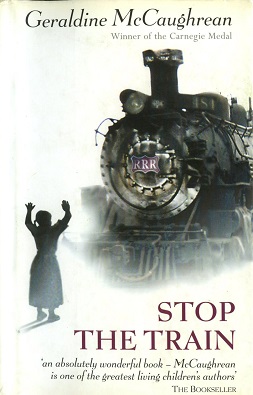Stop the Train facts for kids

First edition
|
|
| Author | Geraldine McCaughrean |
|---|---|
| Country | United Kingdom |
| Language | English |
| Genre | Historical fiction |
| Publisher | Oxford University Press |
|
Publication date
|
18 October 2001 |
| Pages | 238 pp |
| ISBN | 978-0-19-271901-0 |
| OCLC | 47271408 |
| LC Class | PZ7.M1286 St 2001 |
| Followed by | Pull Out All the Stops! |
Stop the Train is an exciting children's novel written by Geraldine McCaughrean. It was first published in 2001. This book won the Bronze Award in the Nestlé Smarties Book Prize. It was also a finalist for the important Carnegie Medal. Plus, it was nominated for the Stockton Children's Book of the Year award.
Contents
What is Stop the Train About?
This story takes place during the Oklahoma Land Run. This was a time in American history when people raced to claim new land. A young girl named Cissy and her family arrive in a brand-new settlement called Florence Town. They hope to build a new life there.
The Railroad Problem
Soon after they arrive, a big railroad company decides it wants the land where Florence Town is built. The company tries to buy the land from the townspeople. But the people of Florence Town do not want to sell their homes and farms.
Because the townspeople refuse to sell, the railroad company's director makes a harsh decision. He announces that no trains will ever stop in Florence Town. This causes big problems for the town. Without a train stop, it's hard for people to get supplies or travel.
Fighting for Florence Town
Life becomes very difficult without a train connection. The people of Florence Town decide they must do something. They try different ways to make the train stop. Some of their ideas are legal, and some are a bit risky.
The story follows Cissy as she grows up in this struggling town. It shows how the people work hard to survive and make a living. They come up with a clever plan to get the train's attention.
The Florence Fair
The townspeople decide to hold a special event called the Florence Fair. They want to show off their community. To get visitors, some men from the town manage to get on a train passing by. They convince the passengers to come to their fair.
The Florence Fair is a big success! The passengers are impressed by the town and its people. After seeing Florence, they put pressure on the railroad company. They demand that the company stop ignoring Florence Town. Some even start to boycott, or refuse to use, the trains.
A Risky Plan
The people of Florence Town don't know about the boycott. They are quite cut off from the rest of Oklahoma. Then, a sad rumor spreads: a young girl has died under the wheels of a train. This makes the townspeople very angry and desperate.
They decide to take a drastic step. They plan to stop the train by removing a section of the railway track. This would block the road crossing. It's a dangerous act of sabotage.
Averting Disaster
Just in time, the townspeople realize the danger. They understand that the people on the train are not responsible for their problems. They quickly work together to fix the track before the train arrives. They manage to prevent a terrible accident.
After this, they get good news. The train company has changed its mind! Trains will now stop at their station. To celebrate this new beginning, Florence Town gets a new name: Olive. This name is a symbol of peace and a fresh start with the railroad company. That's why the train line becomes known as the "Olive Branch Line."
Real-Life Inspiration
The book might have been partly inspired by a real event. This event was called the Enid–Pond Creek Railroad War. It happened in Oklahoma. The book is dedicated to the people of Enid, who really did manage to stop a train.
What Happens Next?
Cissy's adventures continue in a sequel to Stop the Train. The next book is called Pull Out All the Stops! It was published in 2010. In the United States, this book is known as The Glorious Adventures of the Sunshine Queen. In this story, Cissy stays with her old teacher, Miss Loucien. They live on an old showboat that is home to the Bright Lights Theatre Company.

